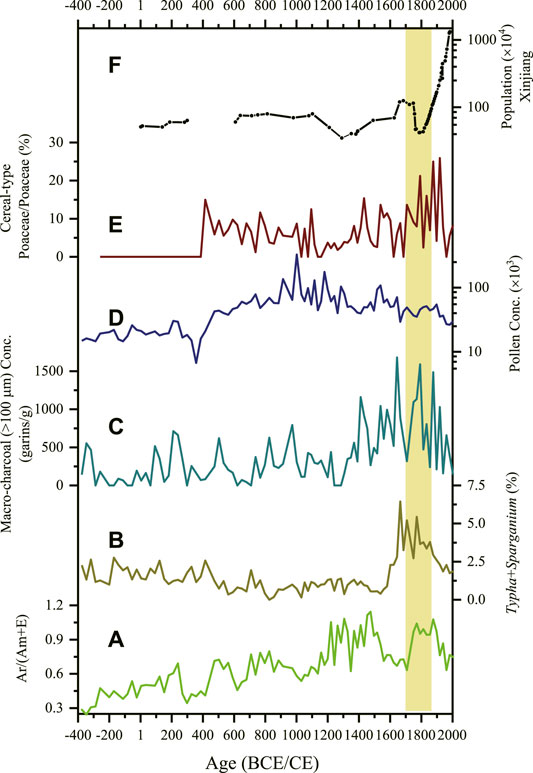
94% of researchers rate our articles as excellent or good
Learn more about the work of our research integrity team to safeguard the quality of each article we publish.
Find out more
CORRECTION article
Front. Earth Sci., 10 May 2022
Sec. Quaternary Science, Geomorphology and Paleoenvironment
Volume 10 - 2022 | https://doi.org/10.3389/feart.2022.903702
This article is a correction to:
Moisture Changes in the Northern Xinjiang Basin Over the Past 2400 years as Documented in Pollen Records of Jili Lake
A Corrigendum on
Moisture Changes in the Northern Xinjiang Basin Over the Past 2400 Years as Documented in Pollen Records of Jili Lake
by Xiao, Y., Xiang, L., Huang, X., Mills, K., Zhang, J., Chen, X., and Li, Y. (2021). Front. Earth Sci. 9:741992. doi:10.3389/feart.2021.741992
In the original article, there were multiple errors in the text. A correction has been made to the Abstract, whereby the line “northern Xinjiang remainly largely unclear” should read “northern Xinjiang remains largely unclear”.
Another correction is introduced on page 6, in the section sub-titled “Comparison of Regional Moisture Changes in the Late Holocene”. Figure 5 should be the only cited figure in this section and Figures 3 and 4 were mentioned erroneously. Further the first abbreviation of “PHI” should read “pollen humidity index (PHI)”, and Line 14 “Yushenkushi Peat” should read “Yushenkule Peat”.
On page 8, Line 4 the citation of Figure 5B should read Figure 5I, and in Paragraph 2, Line 13 the figure citation Figures 6B,C,E should read Figures 6B–D.
Some corrections were also made in the Conclusion. The section should read as follows:
“The high-resolution pollen record from core JL18-02-A reveals the evolution of vegetation in Jili Lake and its surrounding area over the last 2400 years in response to climate drivers and human impact (…)
Pollen assemblages indicated that regional vegetation dominated by desert gradually shifted into a desert steppe. The moisture was characterized by the “warm-dry” periods of RWP (c. 1 to c. 400 CE), MWP (c. 850 to c. 1200 CE) and CWP (since 1850 CE), and the “cold-wet” periods of DACP (c. 400 to c. 850 CE) and LIA (c. 1200 to c. 1850 CE). Over the last 2400 years, the monsoon had little influence on moisture changes in the Jili Lake basin. Notably, during 1700–1850 CE, the increase of the percentages in aquatic pollen (Typha and Sparganium) and cereal-type Poaceae pollen reflecting anthropogonic impacts, and the rise of macro-charcoal and population may result from the intensified irrigation for agriculture in the catchment.
At the end of the main text, two references “(Fang, 1989; Zhang and Feng, 2018a)” should also be deleted.
Finally, in the original article, the author provided incorrect versions of Figures 3 and 7 during proofreading. The correct figures appear below.

FIGURE 7. Comparison of Ar/(Am + E) ratio for the core JL18‐02‐A with population in Xinjiang: (A) Ar/(Am + E) ratio from Jili Lake (this study); (B) The percentage of Typha and Sparganium from Jili Lake (this study); (C) Macro-charcoal (>100 μm) concentration from Jili Lake (this study); (D) Pollen concentration form Jili Lake (this study, c: Y‐axis is a log scale); (E) Ce/Po from Jili Lake (this study); (F) Population in Xinjiang, a: Y‐axis is a log scale (Zhao and Xie, 1988). The orange area indicates a population growth period.
The authors apologize for these errors and state that this does not change the scientific conclusions of the article in any way. The original article has been updated.
All claims expressed in this article are solely those of the authors and do not necessarily represent those of their affiliated organizations, or those of the publisher, the editors and the reviewers. Any product that may be evaluated in this article, or claim that may be made by its manufacturer, is not guaranteed or endorsed by the publisher.
Keywords: moisture change, pollen records, the historical period, climate change, Arid Central Asia
Citation: Xiao Y, Xiang L, Huang X, Mills K, Zhang J, Chen X and Li Y (2022) Corrigendum: Moisture Changes in the Northern Xinjiang Basin Over the Past 2400 Years as Documented in Pollen Records of Jili Lake. Front. Earth Sci. 10:903702. doi: 10.3389/feart.2022.903702
Received: 24 March 2022; Accepted: 05 April 2022;
Published: 10 May 2022.
Edited and reviewed by:
Andrej Aleksandrovic Andreev, Alfred Wegener Institute Helmholtz Centre for Polar and Marine Research (AWI), GermanyCopyright © 2022 Xiao, Xiang, Huang, Mills, Zhang, Chen and Li. This is an open-access article distributed under the terms of the Creative Commons Attribution License (CC BY). The use, distribution or reproduction in other forums is permitted, provided the original author(s) and the copyright owner(s) are credited and that the original publication in this journal is cited, in accordance with accepted academic practice. No use, distribution or reproduction is permitted which does not comply with these terms.
*Correspondence: Xiaozhong Huang, eHpodWFuZ0BsenUuZWR1LmNu
†These authors have contributed equally to this work
Disclaimer: All claims expressed in this article are solely those of the authors and do not necessarily represent those of their affiliated organizations, or those of the publisher, the editors and the reviewers. Any product that may be evaluated in this article or claim that may be made by its manufacturer is not guaranteed or endorsed by the publisher.
Research integrity at Frontiers

Learn more about the work of our research integrity team to safeguard the quality of each article we publish.